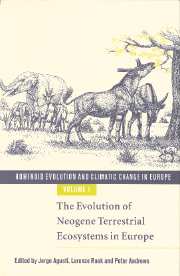Book contents
- Frontmatter
- Contents
- List of contributors
- Acknowledgements: The European Science Foundation
- 1 Introduction
- PART I Palaeogeography of the circum-Mediterranean region
- PART II Miocene mammalian successions
- 5 A critical re-evaluation of the Miocene mammal units in Western Europe: dispersal events and problems of correlation
- 6 Large mammals from the Vallesian of Spain
- 7 Trends in rodent assemblages from the Aragonian (early–middle Miocene) of the Calatayud-Daroca Basin, Aragon, Spain
- 8 The Late Miocene small mammal succession from France, with emphasis on the Rhône Valley localities
- 9 Late Miocene mammals from Central Europe
- 10 An overview on the Italian Miocene land mammal faunas
- 11 The Miocene large mammal succession in Greece
- 12 Chronology and mammal faunas of the Miocene Sinap Formation, Turkey
- 13 The Late Miocene small mammal succession in Ukraine
- PART III Palaeoenvironments: non-mammalian evidence
- PART IV Palaeoenvironments: mammalian evidence
- Index
5 - A critical re-evaluation of the Miocene mammal units in Western Europe: dispersal events and problems of correlation
from PART II - Miocene mammalian successions
Published online by Cambridge University Press: 15 December 2009
- Frontmatter
- Contents
- List of contributors
- Acknowledgements: The European Science Foundation
- 1 Introduction
- PART I Palaeogeography of the circum-Mediterranean region
- PART II Miocene mammalian successions
- 5 A critical re-evaluation of the Miocene mammal units in Western Europe: dispersal events and problems of correlation
- 6 Large mammals from the Vallesian of Spain
- 7 Trends in rodent assemblages from the Aragonian (early–middle Miocene) of the Calatayud-Daroca Basin, Aragon, Spain
- 8 The Late Miocene small mammal succession from France, with emphasis on the Rhône Valley localities
- 9 Late Miocene mammals from Central Europe
- 10 An overview on the Italian Miocene land mammal faunas
- 11 The Miocene large mammal succession in Greece
- 12 Chronology and mammal faunas of the Miocene Sinap Formation, Turkey
- 13 The Late Miocene small mammal succession in Ukraine
- PART III Palaeoenvironments: non-mammalian evidence
- PART IV Palaeoenvironments: mammalian evidence
- Index
Summary
Introduction
The MN mammalian biochronological classification of the European terrestrial record has been the subject of intensive criticism since its first formulation by Mein (1975). More than twenty years later, the question of its validity is still open, although, unlike previous times, we now have ways for falsifying this ‘hypothesis of mammalian succession’ (as it was defined by Agustí & Moyà-Solà, 1991). Originally, the MN ‘zonation’ (as it was sometimes wrongly quoted) reflected a pattern of mammalian turnover in the European terrestrial record, mainly based on supposed large overland dispersals and extinctions. To these two criteria, Mein (1975) also added the successive chronospecies of several European mammalian lineages (mainly rodents) as a third criterion for establishing the MN units. Agustí & Moyà-Solà (1991) proposed a restrictive interpretation of the MN units as a regional, Western European mammal scale based on the stratotypical succession of the Neogene mammal stages defined in a number of Spanish basins (by far, the most complete Neogene succession in Western Europe). A very different approach was that of a reinvented ‘RCMNS working group’ (Bruijn et al., 1992), which proposed to avoid completely the assumed biostratigraphic meaning of the MN units, and to redefine them on the basis of reference-levels, returning to the system proposed in the 1960s by Thaler (1966), and that the Mein (1975) proposal was supposed to surpass. Each MN unit being defined only by an isolated reference-locality, this system remained as a selfish way for paleomammalogists to classify their fossiliferous localities within an assumed chronological background, but without any possibility of falsification or correlation with other biostratigraphic scales, given the absence of a true biostratigraphical background.
- Type
- Chapter
- Information
- Hominoid Evolution and Climatic Change in Europe , pp. 84 - 112Publisher: Cambridge University PressPrint publication year: 1999
- 3
- Cited by



